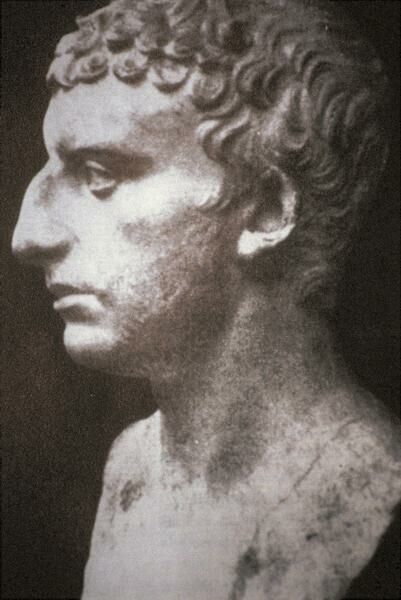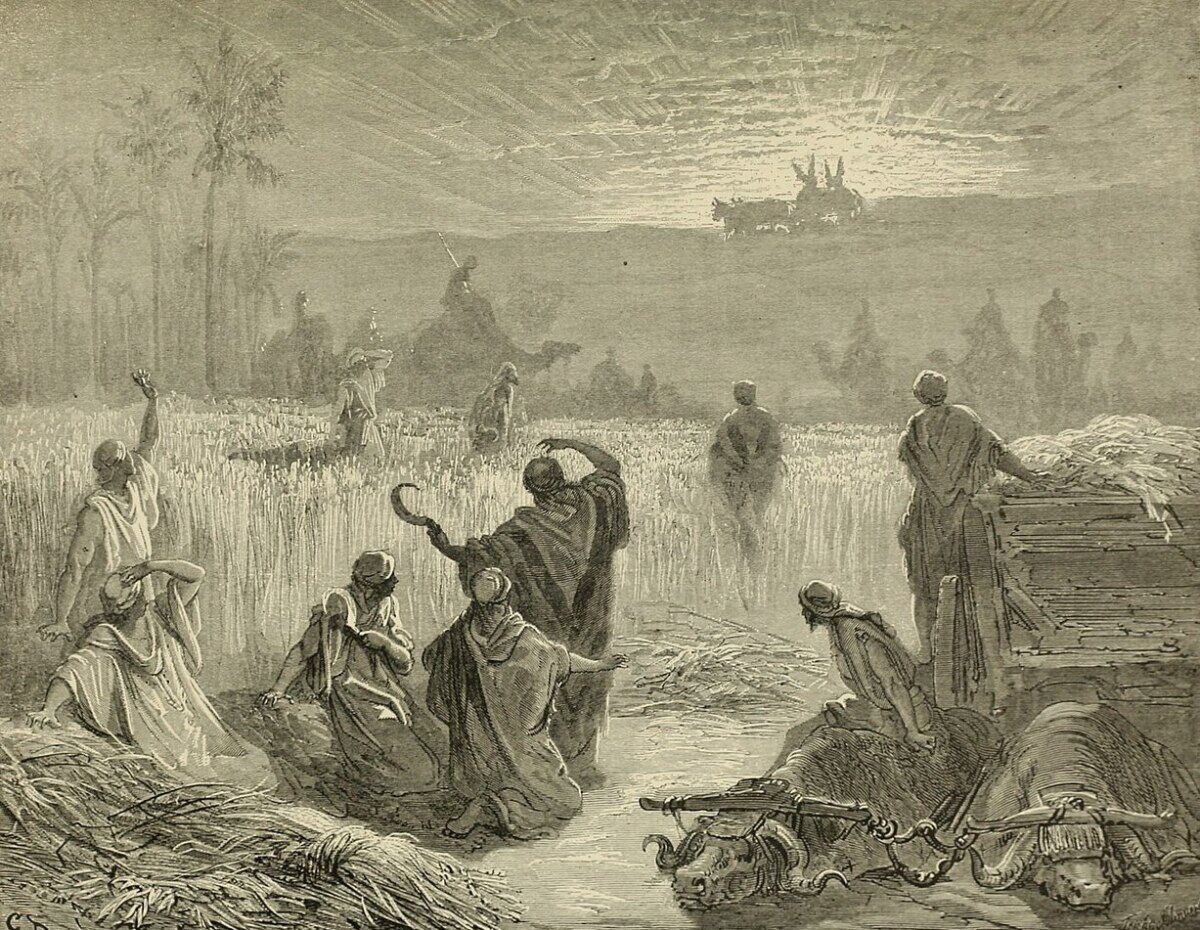The Bible records the reigns of 43 monarchs of Israel and Judah. The regnal lengths of nearly all are recorded in the books of Samuel, Kings and Chronicles from the longest, Manasseh’s 55 years (2 Kings 21:1), to the shortest, Zimri’s seven days (1 Kings 16:15). The regnal lengths of two kings, however, are not provided. One is Tibni—a minor ruler over a breakaway part of Israel during the early days of Omri (1 Kings 16:21-22)—and perhaps more surprisingly, the very first king of all: Saul.

Yet the standard regnal length formula for Saul is provided in 1 Samuel 13:1. The problem is, this formulaic verse is highly unusual: The numbers appear to be missing. Additionally, the age at which Saul began to reign and the age at which he died are not given.
Why so much ambiguity? Can we know how long Saul reigned?
A Peculiar Verse
The typical regnal formula is as follows: “[Name] was [number of] years old when he began to reign; and he reigned [number of] years in [location].” Take 2 Kings 21:1 as an example: “Manasseh was twelve years old when he began to reign; and he reigned five and fifty years in Jerusalem.”
In Hebrew, that formula can be given as follows (note that Hebrew reads from right to left and the age is given first, followed by the name):

Manasseh’s reign is thus recorded:

This formula, or a variation, is used repeatedly in the Bible. In some cases, it is lengthened to highlight different periods of rule from different locations (as in the case of David in 2 Samuel 5:4-5). Or in many cases it incorporates the year of rule that the neighboring king (from Israel or Judah) was in when the present one began his reign.
Notice, however, 1 Samuel 13:1. Here we have the same formula for King Saul, with the following text (note that the Hebrew word for “years” can be either שנה or שנים—in this case, it is the latter):

This verse is very peculiar: No numbers of age are given between the first two words. His name is, of course, provided (third word from the right), but then only the number “two” is specified (red, middle) for the number of years reigning as king “over Israel” (red, left).

Technically, the initial term “בן שנה” does make sense in Hebrew without a number, but this would literally mean “a year old”—and Saul certainly wasn’t “a child of one year” when he began to reign (Douay-Rheims translation notwithstanding). And regarding the middle part of this verse, other passages make clear that he reigned for significantly longer than two years.
The way this verse is handled by various translations highlights the difficulty in interpretation—and to a degree, they make matters worse.
Trouble in Translation
Over the centuries, translators have wrestled with this verse, providing various interpretations. The King James Version (kjv) translates verse 1 and the first part of verse 2 as follows: “Saul reigned one year; and when he had reigned two years over Israel, Saul chose him three thousand men of Israel ….” The English Standard Version (esv) translates it: “Saul lived for one year and then became king, and when he had reigned for two years over Israel, Saul chose three thousand men of Israel ….”
The trouble with such translations, besides the seemingly meaningless initial reference to “one year,” is that, in recognizing Saul must have reigned longer than two years over Israel, they necessarily make verse 1 a lead-in to the content of verse 2 by adding “and when he had ….” Yet verse 1 in the Hebrew stands on its own, as the typical regnal formula. Further, in the original Hebrew, verse 2 starts a new train of thought with the word “And”: “And Saul chose him three thousand men of Israel ….” In adding leading words into the first verse, the same translations also necessarily have to remove this introductory “And” in the second verse in order to incorporate it into their reinterpretation of the first.
A somewhat better rendering of 1 Samuel 13:1 is given in the Jewish Publication Society (jps) translation: “Saul was a— years old when he began to reign; and two years he reigned over Israel.” A brief footnote states: “aThe number is wanting in the Hebrew.” The Revised Standard Version (rsv) translates it: “Saul was … years old when he began to reign; and he reigned … and two years over Israel.”
This theory that part of the latter number is also missing—“… and two years”—has produced several theories for Saul’s reign: “twenty and two,” “thirty and two” or “forty and two.” (Some offer a 12-year reign; note that the number 12 is formulated differently in Hebrew with the two before the ten, rather than after.)

In cases of such textual ambiguity, the Septuagint (lxx), a second-century b.c.e. Greek translation of this biblical text, is often turned to for clarification. When it comes to enigmatic verses, an early translation can sometimes be helpful in shedding light on information that may have become lost in later centuries. Yet 1 Samuel 13:1 is entirely missing from the Septuagint. The immediate verses on either side—1 Samuel 12:25 and 1 Samuel 13:2—are included, which seems to imply that verse 1 was likewise an enigmatic passage for lxx translators—so much so, that they elected to omit the verse entirely.
Putting 1 Samuel 13:1 to one side for now, are there any other clues for the length of Saul’s reign?
Consulting Another Saul
Interestingly, the length of Saul’s reign is given outright in the New Testament, by an individual of the very same name and same Benjamite tribal affiliation (Philippians 3:5). Saul—later named Paul (Acts 13:9)—gave a speech in Antioch in Pisidia (modern-day Isparta Province, Turkey), recounting Israel’s history. Of King Saul, he stated: “Then they asked for a king; and God gave them Saul the son of Kish, a man of the tribe of Benjamin, for forty years” (verse 21; rsv).

For many Christian readers, this statement is sufficient proof for the length of Saul’s reign. (It’s why several translations add “forty and two” to 1 Samuel 13:1—this considers Paul’s reference to 40 a rounded figure, and 1 Samuel 13:1 as referring more specifically to 42 years for Saul’s reign.)
Of course, many others (particularly those of other religious convictions) will not be so quick to accept this statement from Paul. Still, it’s worth pointing out in this context Paul’s upbringing and education as a devout Pharisee (Philippians 3:5-6). Further, the length of King Saul’s reign is not considered controversial or disputed by the members of this synagogue in Acts 13—rather, it is a side point taken for granted as part of an intentionally familiar storyline (verse 14). Thus it could safely be assumed that King Saul’s reign was fairly widely recognized by the community as having been around 40 years.
There’s further reason for that—from another Jewish source on the scene at the same time.
Enter Josephus
Ellicott’s Commentary writes: “A more definite corroboration of St. Paul’s statement is given by [first-century Jewish historian] Josephus (Antiquities of the Jews 6.14.9), who states that he [Saul] reigned 18 years before Samuel’s death and 22 after it.” Similarly, the Cambridge Bible for Schools and Colleges notes: “Josephus … expressly states that” Saul’s reign was “40 years.”

In Antiquities of the Jews, Josephus writes: “Now Saul, when he had reigned 18 years while Samuel was alive, and after his death two and twenty, ended his life in this manner.”
Unfortunately, even here Josephus’s accounting is debated. Some manuscripts give 20 years (18+2), rather than 40 (18+22). Yet even some who prefer the lower number for Josephus recognize that clearly “in Acts 13, Paul is no doubt repeating what was the Jewish tradition of the time: a 40-year reign for Saul.”
And despite some theories to the contrary, this number 40 (or more specifically, 42) was not simply pulled from thin air; other biblical passages assist in determining this as the regnal length of King Saul.
Additional Points
1 Samuel 9-10 describe the young Saul’s journey to look for his father’s lost asses with a servant. During this journey, Saul came into contact with the Prophet Samuel, who anointed him king (1 Samuel 10:1). Verse 2 of chapter 9 describes him as a “young man” at the time (a word also variously translated “youth”). Yet he was still fully grown (“from his shoulders and upward he was higher than any of the people”). Based on this statement of “youth,” he was quite conceivably in his late teens or early 20s. More consequentially, Gesenius’ Hebrew-Chaldee Lexicon notes that the specific Hebrew word used here “denotes a young man of mature age, but unmarried.” Indeed, passages throughout the Hebrew Bible use such terminology to refer to “young men” alongside their unmarried female counterparts, “virgins” (e.g. Deuteronomy 32:25; Ruth 3:10; Psalm 78:63; Isaiah 62:5; Lamentations 1:18; Amos 8:13).
Compare this with 2 Samuel 4:4, which records that Saul was a grandfather by the time he died. This would dispel the notion that Saul reigned for as little as two or 12 years; it would also make a 22-year reign extremely implausible.
Also notable is the account of Saul’s two daughters, Merab and Michal, who were grown and of marriageable age (1 Samuel 18) when the young David was serving in Saul’s royal court. David later fled for his life, ultimately becoming king at the age of 30 (2 Samuel 5:4). Though the duration of David’s lengthy time on the run is nowhere specified, various commentators typically posit anywhere from seven to 13 years. Adding these years to the age of his grown daughters, Saul’s reign must have been significantly longer than 20 years, and more likely around 30 years or more.

The most consequential passage, however, is 2 Samuel 2:10. After Saul’s death, his son Ishbosheth succeeded him as king: “Ishbosheth Saul’s son was forty years old when he began to reign over Israel, and he reigned two years.” Saul was anointed as a young, unmarried man—and was ultimately succeeded by a 40-year-old son. Further, Ishbosheth was not even originally the heir apparent. Jonathan was Saul’s firstborn (e.g. 1 Samuel 20:31), but he died alongside two other brothers and their father during a battle with the Philistines.
Ishbosheth’s age upon assuming the throne therefore fits with a 40- to 42-year reign for Saul—a regnal length for which we already have corroborating testimony from the first century c.e.
What About the Ark of the Covenant?
There is one particular counterpoint that is brought up by proponents of a short reign for Saul. 1 Samuel 4-5 describe the capture of the ark by the Philistines. Before the reign of Saul, the ark was returned to Israel (1 Samuel 6). Following a deadly incident at Beth Shemesh, the ark was sent to the “house of Abinadab” at Kirjath Jearim. “And it came to pass, from the day that the ark abode in Kiriath-jearim, that the time was long; for it was twenty years; and all the house of Israel yearned after the Lord” (1 Samuel 7:1–2). It is therefore inferred that the ark stayed at Kirjath Jearim for 20 years before it was brought into Jerusalem during the early part of the reign of David (2 Samuel 6).
In The Old Testament Story (2nd edition), John Tullock writes:
The length of Saul’s reign is uncertain since a number is missing in the Hebrew text [of 1 Samuel 13:1] …. If one takes the biblical evidence, 12 years might be more logical. The ark was captured by the Philistines some time before Saul began to reign. According to 1 Samuel 7:2, it was kept in Kiriath-jearim “some twenty years.” It was taken to Jerusalem in the early part of David’s reign (2 Samuel 6:1-15), but David reigned for over seven years at Hebron before Jerusalem was captured (2 Samuel 5:5). If this 20 years is to be taken literally or even as meaning around 20 years, it would seem to limit Saul’s reign to no more than 12 years.
It’s a good point: How can 1 Samuel 7:1–2 fit into the chronology of Saul’s rule? Actually, there is a fair amount of unanimity among the commentaries in answering this. As noted, for example, in the Benson Commentary: “It is not said that this space of 20 years was all the time of the ark’s abode there, for it continued there from Eli’s time till David’s reign ….”
As Benson pointed out, the ark was taken by the Philistines at the very same time as Eli’s death (1 Samuel 4:17-18). It remained with the Philistines only seven months before it was returned to Israel (1 Samuel 6:1). After its defilement upon arrival at Beth Shemesh, and the deadly plague that followed, it was immediately sent on to Kirjath Jearim, per 1 Samuel 6:21. This verse shows that it was forwarded on to Kirjath Jearim from Beth Shemesh shortly after it had arrived from Philistia. Indeed, the men of Kirjath Jearim—just 13 kilometers (8 miles) from Beth Shemesh—had apparently not yet even heard that the ark had been returned by the Philistines.

Thus, the ark of the covenant’s residence at Kirjath Jearim evidently spanned the entire judgeship of Samuel, followed by the reign of Saul, and then at least seven years into the reign of David. As Benson brings out, the “twenty years” of 1 Samuel 7:2 therefore cannot be a marker for how long the ark remained in Kirjath Jearim. Instead, 1 Samuel 7:2 provides a timeframe for how long it took before Israel “yearned after the Lord.” In the words of Benson, “twenty years before they were brought to a proper sense of their sinfulness and guilt, and so humbled as to deplore their apostasy with genuine godly sorrow, and seek after the favor of God, and reconciliation with him,” during the judgeship of the Prophet Samuel.

The same point is made by the Cambridge Bible Commentary: “Twenty years was not, as the [kjv] seems to imply, the whole duration of the ark’s sojourn at Kirjath Jearim, but the time that elapsed before the reformation now to be recorded.” The Pulpit Commentary describes a wait of “20 years before deliverance came”—a deliverance that was fulfilled during the days of Samuel.
Notice 1 Samuel 7:2–3 again, in light of this: “And it came to pass, from the day that the ark abode in Kiriath-jearim, that the time was long; for it was twenty years; and [then] all the house of Israel yearned after the Lord. And Samuel spoke unto all the house of Israel, saying: ‘If ye do return unto the Lord with all your heart ….’”
From Gill’s Exposition of the Entire Bible:
It could not be less than between 40 and 50 years [that the ark remained at Kirjath Jearim], for it remained here until the times of David, who removed it from hence after he was made king over all Israel, and when he had reigned over Judah seven years; and from the death of Eli to that time, which included the government of Samuel and Saul, it could not be less than what has been hinted: for it was 20 years; not that this was all the time the ark was at Kirjath Jearim, but it was so long there before it was much taken notice of, and sought unto, and the Lord by it; there was a great neglect of God, and his worship, which through the means of Samuel began to revive about this time.
‘The Time Was Long’
This, in my opinion, serves as the best explanation of the 1 Samuel 7 passage—particularly in light of several additional scriptures, pointing to this same conclusion.
In the 2 Samuel 6 account of the removal of the ark by David, there is no mention of the original individual, Eleazar, who in 1 Samuel 7:1 was “sanctified” to “keep the ark.” Instead, two entirely different, unfamiliar individuals are looking after the ark: Ahio and the infamous Uzzah, who died after mishandling it. Is the lack of mention of the original keeper of the ark just coincidental? Or had this “sanctified” individual long since died—the ark now in the hands of individuals who had forgotten (or ignored) how to properly handle it?
Additionally, if everything is to be compressed into this 20-year period—from the death of Eli into at least the eighth year of David’s reign—how best to explain Eli’s great-grandson Ahiah on the scene and serving as priest, “wearing the ephod,” well within the reign of Saul? (1 Samuel 14:3; note also that Ahiah’s uncle, Ichabod, was only born at the same time Eli died—1 Samuel 4:18-21). Not to mention the later leading priest Ahimelech, followed by Abiathar, both on the scene still within the reign of Saul (a priestly succession pointed out by Gill’s Exposition).
Further, how best to explain the length of judgeship of not only Samuel, but also his later appointment of his own two grown sons, Joel and Abiah, and their tenure in Beersheba—all well before the Israelite elders even approached the prophet in request of a king? Especially considering Samuel was only a child when Eli was already an elderly man (1 Samuel 3). Further to this end, what about Samuel’s grandson, Heman—son of Joel—who, at the time of the ark’s removal, was appointed by David as one of the leaders of the procession? (1 Chronicles 15:14-25 and 6:18; 6:33 in other translations).
These passages collectively speak to the length of time, not only for the ark at Kirjath Jearim, but also the long judgeship of Samuel and lengthy reign of Saul.
Philistine Problem, Samuel Solution
This answer actually resolves another, otherwise confounding problem. 1 Samuel 7 marks the end of the decades-long Philistine oppression (Judges 10:7). Yet does it make sense to describe this time as a lynchpin moment, marking the end of Philistine oppression—only for the Philistines to immediately turn around and exert near-total, oppressive control over Israel during the early part of Saul’s reign?
This is again resolved, in my opinion, if we do not confine the end of the Philistine oppression, Samuel, Saul and the first part of David’s reign into this 20-year period.
This would have the Philistine oppression ending 20 years into the ark’s residence at Kirjath Jearim, 20 years after the death of Eli—at a time when the Israelites began to turn to God and follow the Prophet Samuel’s direction. The miraculous destruction of the Philistine army in 1 Samuel 7, in answer to the prophet’s prayer, would then be followed by a significant period of peace throughout the sole judgeship of Samuel (perhaps two or three decades), prior to the reign of Saul. “So the Philistines were subdued, and they came no more within the border of Israel; and the hand of the Lord was against the Philistines all the days of Samuel” as judge (verse 13)—all the way up until the days of Saul’s rule.
Following the Israelite elders’ ultimate rejection of Samuel’s leadership (or rather, God’s—1 Samuel 8:7), and the ordination of Saul in the fulfillment of their request for a king “like all the nations” (1 Samuel 8:5), the floodgates were once again reopened for Philistine domination.
Back to 1 Samuel 13:1
Armed with the above information, we now return to our enigmatic regnal length formula for King Saul. Again, it is apparent that information is missing from this text (importantly not mistaken, but rather omitted), in relation to this king’s reign. “Saul was … years old when he began to reign; and he reigned … and two years over Israel” (1 Samuel 13:1; rsv).
Based on the above data, I believe the collective evidence best points to the number 40 as missing from the last part of this formula, making Saul’s total reign 42 years (and therefore Paul’s statement in Acts 13:21 a rounded figure—similar to another clearly rounded figure given by him in the prior verse). Perhaps unsurprisingly, this is the figure supplied in most modern English translations of the passage—“[forty] and two years.”

Regarding Saul’s age when coronated, some translations, based on certain later Greek manuscripts, also add “30.” The age of Saul when he assumed the throne is not central to this article, but I would view 30 years old with a degree of skepticism, due in part to the biblical emphasis on his initial youth and also the fact that he died in the heat of battle with his troops (1 Samuel 31). Was Saul in his 70s at the time? It seems more reasonable that he was anointed as a “young man” in his late teens, or around the age of 20 and died four decades later, around the age of 60.
Such a long regnal length for Saul might come as a surprise, especially for those who may have otherwise assumed a short reign for the king. Still, the biblical account of his reign is far more filled out than the reigns of the far longer-ruling later monarchs like Uzziah (52 years) and Manasseh (55 years). And reviewing the account with this extended period in mind, certain events and peculiarities lock into place. As Dr. Herman Hoeh wrote in his Compendium of World History, Volume 1:
After his anointing by Samuel there were almost 20 years … for which we have no record in the Bible. The country went to pieces under Philistine and Amalekite invaders. Then Saul regained his power for 20 years …. One year later (following his return to power) Saul appointed his now-grown son Jonathan to assist him in a military campaign against the Philistines. … God intervened on behalf of Israel with a tremendous earthquake that shook the Earth (1 Samuel 14:15). “So Saul took the kingdom over Israel” (1 Samuel 14:47) after this great event. He then gathered a great host against the Amalekites and defeated them (1 Samuel 14:48). This account is amplified in 1 Samuel 15:1-9.
This would explain the strange biblical passage halfway through Saul’s reign: “So Saul [re]took the kingdom over Israel” (1 Samuel 14:47)—reasserting his rule militarily, with his now-grown offspring at his side.
A significant question, however, remains: Why would numerical text for 1 Samuel 13:1 be “missing”?
The Blotting Out of Saul?
Again, this would not be a case of Bible error—rather, of an apparently fragmentary text. One answer could be that such text, originally written in full, had been damaged in an original manuscript beyond recognition—and thus only what was clearly readable was transmitted by a scribe (with the fearful injunction in mind that curses would follow for the one who would wrongly add to or subtract from the Scriptures—e.g. Deuteronomy 4:2; 12:32).
But there might be more at play here. The line “Saul was … years old when he began to reign; and he reigned … and two years over Israel” looks very much like something known as damnatio memoriae (“condemnation of memory”): excising names or dates from records, in punishment or condemnation of an individual. This is often found on ancient monuments. One can certainly imagine such a line relating to Saul in some kind of an official, monumental royal inscription—a record on which the dates of the king’s reign had been struck out (perhaps with barely the end of the last number, and two, visible). Could this perhaps account for the peculiarity of this verse, and the missing information contained within?

For later kings, from David onwards, we have numerous means of regnal calculation, in some cases to the very day. We have ages of kings when they assumed the throne, ages of kings when they died, the length of time in which they sat on the throne, ages in comparison to other rulers, the length of time in which they ruled from various regions. For Saul, we have nothing in these records of ancient Israel. Is this just coincidence?
Or could the lack of all such data be deliberate—a “blotting out,” to use biblical language (e.g. Exodus 32:33)—a final punishment for Saul’s rebellious, at times demon-possessed (1 Samuel 16:14) and witchcraft-likened and -influenced reign (1 Samuel 15:23, 28:7-25)—one which saw his sanction of such atrocities as the massacre of the priestly town of Nob? (1 Samuel 22).
In the damning words the Prophet Samuel relayed to Saul from God: “For rebellion is as the sin of witchcraft, and stubbornness is as idolatry …. Because thou hast rejected the word of the Lord, He hath also rejected thee from being king. … [T]hou has rejected the word of the Lord, and the Lord hath rejected thee from being king over Israel” (1 Samuel 15:23, 26).
Perhaps it’s fitting, then, that the reign of Saul goes from one of the longest in Israel’s history, to “….”

